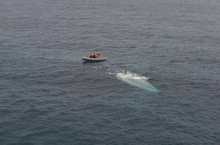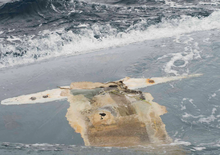Cheeki Rafiki
|
||||||||||||||||||
|
||||||||||||||||||
|
||||||||||||||||||
|
||||||||||||||||||
Cheeki Rafiki was a yacht of the type Beneteau First 40.7 , which was used for regattas. Its accident on May 16, 2014 sparked an extensive debate about the safety of sailing boats. The yacht hadlostits keel about 720 nautical miles (about 1300 kilometers) southeast of Nova Scotia and overturned. Rescue workers were able to locate the capsized hull, but the crew - four English men - was never found.
The ship
Cheeki Rafiki was a Bénéteau First 40.7 that was built in 2006 in the Bénéteau shipyard in Saint-Hilaire-de-Riez in France . It was nearly 12 m long. In December 2006 she was delivered to the owner and was intended for charter regattas around Great Britain. In 2011 the company Stormforce Coaching took over the management (but not the ownership) of the yacht and then registered her twice for the Atlantic Rally for Cruisers (ARC), namely in autumn 2011 and in autumn 2013. In the following winter months she stayed in the Caribbean . The accident happened during the return trip from the Caribbean to England in spring 2014.
Central to the later investigation into the accident was the construction of the hull and in particular the connection between the outer shell and the so-called “matrix”, an inner floor that was glued into the shell to stiffen the hull and achieve the necessary stability. The keel bolts (9 by 24mm and 1 by 14mm) were firmly cast into the keel. They were passed through the outer shell, the matrix and a steel base plate and secured with nuts from above. The construction process and the construction corresponded to the version of the CE directive for category A recreational boats (high seas) valid at the time of construction and was also checked by the renowned classification society Bureau Veritas .
Her name is reminiscent of the character Rafiki from the animated film The Lion King .
The misfortune
The last known position of the Cheeki Rafiki
|

The Cheeki Rafiki took part in the Antigua Sailing Week in spring 2014 and should then be returned to Southampton in England for the following season . On May 4th, she left Antigua with a crew of four on board. The trip should take approximately 30 days. During the crossing, the skipper exchanged emails with the director of the operating company Stormforce via satellite phone, in particular about the expected weather. In particular, he gave recommendations regarding the route to be chosen. After the wind was weak to very weak during the first few days of the crossing, it increased continuously after May 10th. On May 15 - it was now blowing at 7 Beaufort with a corresponding swell - the skipper reported after being hit by a large wave that the ship was making quite a bit of water, but the cause could not be found. Later there was a phone call via the satellite phone, but the quality of the connection was insufficient. The director then called the MRCC Falmouth , whereupon a search was started. The RCC Boston , which is responsible for the search area, then dispatched an HC-130 long-range search aircraft.
On May 17, more than 24 hours after the last contact, the discovered container ship Maersk Kure the Cheeki Rafiki kieloben floating in the water. The keel was missing, but the rudder was still intact. Due to bad weather conditions, the wreck could not be examined more closely. It was only about a week later that a US Navy ship succeeded in dropping a diver on the (still floating) wreck. He was able to determine that the life raft was still stowed in its intended position. The crew apparently had run out of time to deploy them. Various photos of the upturned hull were also taken, which were later central to the accident investigation. The search was stopped soon after, as there was no hope of finding the crew alive - the maximum time a swimmer can survive in the water at 16 ° C is around 15.5 hours.
examination
The accident sparked heated discussions in the yachting scene about the safety of sailing ships and in particular about the dimensions of the keel-hull connection, which is vital for sailing ships and which had obviously failed here. In particular, it was speculated that in order to gain an advantage in the competitive market for cheap sailing yachts, the shipyard would not have dimensioned the keel connection and the overall hull stability adequately for cost reasons. However, the report by the UK Marine Accident Investigation Branch showed that the design had complied with the regulations, in fact, it was almost in compliance with the now updated regulations. The shipyard could not be reproached with regard to the stability, except perhaps that it had just moved close to the valid limit, which is understandable for economic reasons.
The crew could not be blamed either, because they had the necessary competence and the skipper was in possession of all the certificates and certificates required for this trip on a professional basis. The weather was rough with Beaufort 7, but well within the permissible conditions for a CE category A boat . However, the investigation report mentions that it was unclear whether the boat should have been allowed to make the trip from a legal point of view, as far-reaching regulations regarding equipment, crew and annual safety inspections apply to professionally deployed yachts for worldwide travel. The latter was actually overdue because the operator wanted to have it carried out in England first to avoid the costs of an inspection in the Caribbean.
The investigation report tries to find out why the keel has now loosened, even though the dimensions should have been sufficient in purely mathematical terms and due to the conditions prevailing at the site of the accident. The Cheeki Rafiki was not available to the investigators for their task, because the wreck has not yet been found. So they had to draw their conclusions from the few pictures taken by the search teams, the history of the ship and reports on sister ships. It is known that the Cheeki Rafiki hit the ground several times, but this happens every now and then with a ship used for regatta and training purposes - according to the statements of the investigating commission of experts - and is even deliberately brought about under moderate conditions. She had been repaired several times in the area of the keel base and the connection between the “matrix” and the hull due to several violent grounding. It turned out that the construction of the ship made it almost impossible, even for experts, to see how much the ship's structure had been damaged. The experts also disagreed on how to repair such damage. The manufacturer's recommendation to remove the keel for this was supported, but it was unclear what would justify this time-consuming procedure.
The report states that the likely cause of the accident was the loosening of the bonded connection between the "matrix" (inner shell) and the fuselage. The investigating authorities were able to trace the corresponding damage to several sister ships that had also hit the ground. Several repair shops surveyed stated that it was very difficult for them to assess such damage and that they could not say with certainty that the damage had been repaired (the adhesive bond cannot be seen). It is also not possible for a skipper to say whether damage has occurred after a “slight” grounding. It is suspected that one of the previous bottoming of the Cheeki Rafiki had not been adequately repaired and that the stability was no longer sufficient when the swell increased. The pictures of the hull floating upside down show that the layers of the hull had separated from each other. Most of the screws including the base plate are broken through the cover. Some may have broken due to corrosion.
Although the comprehensive report makes many recommendations, it avoids demanding stricter requirements for the stability of keel-hull constructions, which is why it was also criticized. The report reads as if one were to train more flight crews in the event of a loss of the wings instead of preventing it from happening at all.
accusation
After the report became known, charges were brought against the director of the debt collection company Stormforce and the company itself. The director was accused of fourfold negligent homicide ( manslaugther by gross negligence ). The prosecutor accused the director of insufficient maintenance of the ship to save costs. The yacht was not approved for the high seas and various keel bolts were already damaged before departure.
The jury in Winchester could not agree on a verdict for manslaughter, judged the director and the company but guilty of not found the boat in accordance with the applicable safety standards of the Merchant Shipping Act to have operated. The prosecutor moved the case on.
In the appeal to the Crown Court in Winchester who jurors acquitted the director of the charge of involuntary manslaughter, convicted him and the company Stormforce but the breach of security obligations guilty. The process raised more questions than it answered. Both parties to the proceedings had asked various experts what the position in the Merchant Shipping Act meant, according to which every ship had to report a grounding. The expert opinions on this were completely different. There was also uncertainty about other points of the directive - not least about whether they are binding at all. It remains to be seen whether the accident will lead to an improvement in the situation and clarification of disputed questions of interpretation. The director was eventually sentenced to 15 months probation and his now-in-liquidation company was fined £ 50,000 .
Notes and individual references
- ↑ Cheeki Rafiki: company boss convicted of failing to ensure yacht's safety . The Guardian. July 14, 2017. Retrieved February 25, 2018.
- ↑ Sailor for: Water penetrates
- ^ According to estimates by the RCC Boston, MAIB report, page 13.
- ↑ a b c Report Misses An Opportunity to Make Boats Safer . June 29, 2016. Retrieved October 29, 2016.
- ↑ a b MAIB report, page 28: Almost all [yacht owners and professional yacht skippers asked] agreed that groundings can occur when racing, and that if, in their opinion, it was a 'light' grounding, no inspection for damage was necessary , whereby there are different - overall vague - definitions for a "slight" ground contact.
- ^ Yacht firm boss charged with manslaughter over Cheeki Rafiki deaths . The Guardian. October 7, 2016. Retrieved October 30, 2016.
- ^ Manslaughter charges brought over the death of four sailors in Cheeki Rafiki yacht tragedy . The Telegraph. October 7, 2016. Retrieved October 30, 2016.
- ↑ Cheeki Rafiki - Prosecution alleges yacht owner 'cut corners to save cost . June 8, 2017. Retrieved July 6, 2017.
- ↑ Cheeki Rafiki - Douglas Innes pleads not guilty to six charges . yachtingworld.com. December 6, 2016. Retrieved December 11, 2016.
- ↑ Cheeki-Rafiki - Operator found guilty of failing to ensure yachts safety . Yachtingworld. July 14, 2017. Retrieved July 21, 2017.
- ↑ Stormforce owner convicted in Cheeki Rafiki Trial . Yachting Monthly . September 1, 2017. Retrieved February 25, 2018.
- ↑ Cheeki-Rafiki-Boss cleared of Manslaughter . Yachting World. April 25, 2018. Retrieved May 6, 2018.
- ↑ Cheeki Rafiki yacht boss given suspended sentence over unsafe vessel . BBC.com. May 8, 2018. Retrieved July 10, 2018.
Web links
- Report on the investigation of the loss of the yacht Cheeki Rafiki and its four crew in the Atlantic Ocean, approximately 720 miles east-south-east of Nova Scotia, Canada on May 16, 2014 ; Marine Accident Investigation Branch (MAIB) Report 8/2015 Report (PDF, English), with attachments (PDF, English).
- Lessons from Losses At Sea: “Cheeki Rafiki” Report Misses An Opportunity to Make Boats Safer ; Attainable Adventure Cruising; June 2016.

